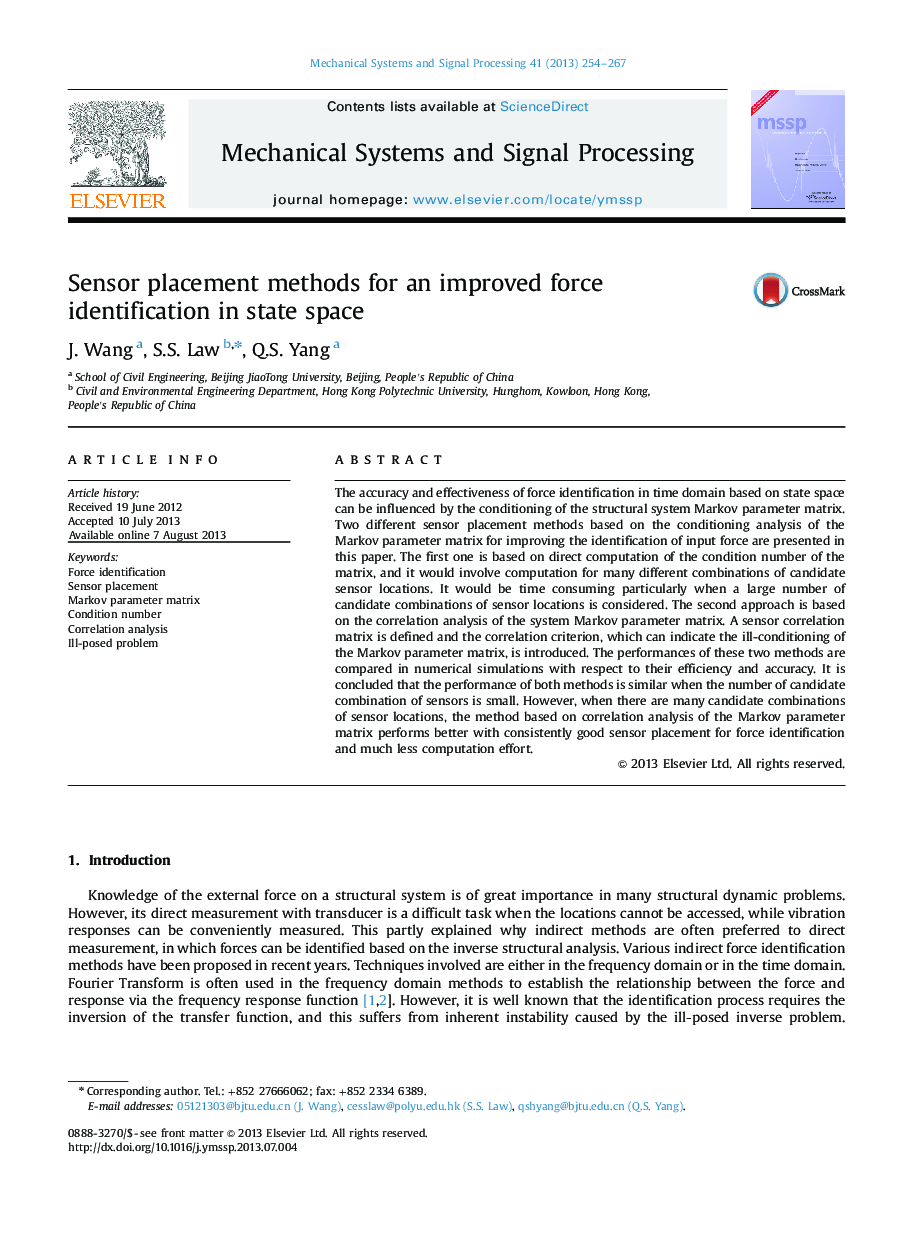| کد مقاله | کد نشریه | سال انتشار | مقاله انگلیسی | نسخه تمام متن |
|---|---|---|---|---|
| 6956543 | 1451876 | 2013 | 14 صفحه PDF | دانلود رایگان |
عنوان انگلیسی مقاله ISI
Sensor placement methods for an improved force identification in state space
ترجمه فارسی عنوان
روش های قرار دادن سنسور برای شناسایی نیروی بهبود یافته در فضای حالت
دانلود مقاله + سفارش ترجمه
دانلود مقاله ISI انگلیسی
رایگان برای ایرانیان
کلمات کلیدی
شناسایی نیرو، قرار دادن سنسور، ماتریس پارامتر مارکوف، تعداد شرایط، تجزیه و تحلیل همبستگی، مشکل منفی،
ترجمه چکیده
دقت و اثربخشی شناسایی نیرو در حوزه زمان بر اساس فضای حالت می تواند تحت تأثیر ماتریس پارامتری پارامتر مارکوف قرار گیرد. در این مقاله دو روش مختلف قرار دادن حسگر بر اساس تحلیل تهویه ماتریس پارامتر مارکوف برای بهبود شناسایی نیروی ورودی ارائه شده است. اولین مورد مبتنی بر محاسبه مستقیم تعداد شرایط ماتریس است و شامل محاسبه برای بسیاری از ترکیبات مختلف مکان های حسگر نامزد می شود. به خصوص زمانی که شمار زیادی از ترکیب نامزدهای مکان های حسگر در نظر گرفته می شود، زمان زیادی صرف می شود. روش دوم بر اساس تحلیل همبستگی ماتریس پارامتر مارکوف سیستم است. یک ماتریس همبستگی سنسور تعریف شده است و معیار همبستگی، که می تواند نشان دهنده بدرفتاری ماتریس پارامتر مارکوف باشد، معرفی می شود. عملکرد این دو روش در شبیه سازی های عددی با توجه به کارایی و دقت آنها مقایسه می شود. نتیجه گیری می شود که عملکرد هر دو روش مشابه است در حالی که تعدادی از سنسورهای ترکیبی نامزد کوچک است. با این حال، زمانی که بسیاری از ترکیبات نامزد از مکان های حسگر وجود دارد، روش بر اساس تجزیه و تحلیل همبستگی ماتریس پارامتر مارکوف بهتر است با قرار دادن حسگر به طور پیوسته خوب برای شناسایی نیرو و تلاش بسیار کمتر محاسبات انجام می شود.
موضوعات مرتبط
مهندسی و علوم پایه
مهندسی کامپیوتر
پردازش سیگنال
چکیده انگلیسی
The accuracy and effectiveness of force identification in time domain based on state space can be influenced by the conditioning of the structural system Markov parameter matrix. Two different sensor placement methods based on the conditioning analysis of the Markov parameter matrix for improving the identification of input force are presented in this paper. The first one is based on direct computation of the condition number of the matrix, and it would involve computation for many different combinations of candidate sensor locations. It would be time consuming particularly when a large number of candidate combinations of sensor locations is considered. The second approach is based on the correlation analysis of the system Markov parameter matrix. A sensor correlation matrix is defined and the correlation criterion, which can indicate the ill-conditioning of the Markov parameter matrix, is introduced. The performances of these two methods are compared in numerical simulations with respect to their efficiency and accuracy. It is concluded that the performance of both methods is similar when the number of candidate combination of sensors is small. However, when there are many candidate combinations of sensor locations, the method based on correlation analysis of the Markov parameter matrix performs better with consistently good sensor placement for force identification and much less computation effort.
ناشر
Database: Elsevier - ScienceDirect (ساینس دایرکت)
Journal: Mechanical Systems and Signal Processing - Volume 41, Issues 1â2, December 2013, Pages 254-267
Journal: Mechanical Systems and Signal Processing - Volume 41, Issues 1â2, December 2013, Pages 254-267
نویسندگان
J. Wang, S.S. Law, Q.S. Yang,
